
Antirrhinum is a genus of plants commonly known as dragon flowers or snapdragons because of the flowers' fancied resemblance to the face of a dragon that opens and closes its mouth when laterally squeezed. They are also sometimes called toadflax or dog flower. They are native to rocky areas of Europe, the United States, Canada, and North Africa. Antirrhinum species are widely used as ornamental plants in borders and as cut flowers.
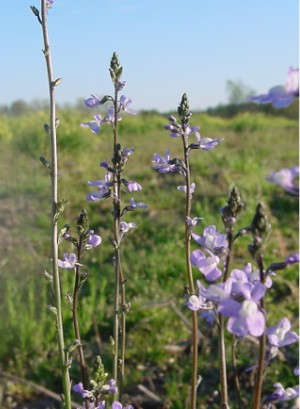
Nuttallanthus is a genus of four species of herbaceous annuals and perennials that was traditionally placed in the foxglove family Scrophulariaceae. Due to new genetic research, it has now been placed in the vastly expanded family Plantaginaceae. Three species of Nuttallanthus are native to North America and one to South America. Nuttallanthus was until the 1980s included in a wider circumscription of the genus Linaria, a genus now considered restricted to the Old World.

Linaria vulgaris, the common toadflax, yellow toadflax or butter-and-eggs, is a species of flowering plant in the family Plantaginaceae, native to Europe, Siberia and Central Asia. It has also been introduced and is now common in North America.

Antirrhinum majus, the common snapdragon, is a species of flowering plant belonging to the genus Antirrhinum. The plant was placed in the family Plantaginaceae following a revision of its prior classical family, Scrophulariaceae.
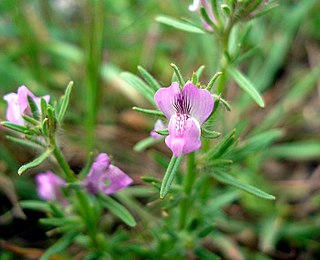
Misopates orontium, known as weasel's snout, is a herbaceous annual plant in the family Plantaginaceae. It is a native of disturbed ground in Europe. It is also naturalised as a weed in other parts of the world such as North America. The pink flowers resemble a miniature snapdragon and are followed by a hairy green fruit which is said to resemble a weasel's snout.
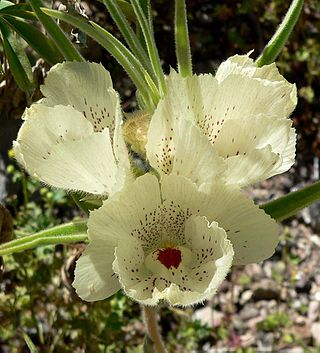
Mohavea is a plant genus consisting of two species native to the deserts of the southwestern United States and northern Mexico. This genus is often included in the closely related snapdragon genus Antirrhinum.

Cymbalaria muralis, commonly called ivy-leaved toadflax or Kenilworth ivy, is a low, spreading, viney plant with small purple flowers, native to southern Europe. It belongs to the plantain family (Plantaginaceae), and is introduced to many other temperate locations. The flower stalk is unusual for seeking light until it is fertilized, after which it grows away from the light. Other names include coliseum ivy, Oxford ivy, mother of thousands, and wandering sailor.
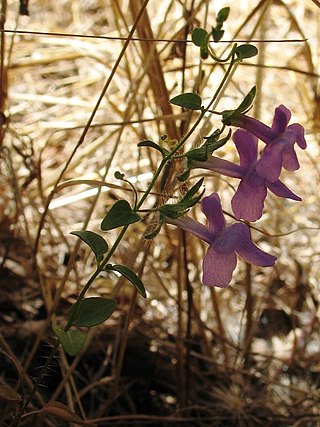
Sairocarpus vexillocalyculatus is a species of New World snapdragon found only in California and occasionally Oregon. This wildflower is known by several common names, including wiry snapdragon, sailflower snapdragon, and Brewer's snapdragon.

Chelone is a genus of four species of perennial herbaceous plants native to eastern North America. They all have similarly shaped flowers, which vary in color from white to red, purple or pink. Chelone cuthbertii, C. glabra, and C. lyonii are diploid and C. obliqua is either tetraploid or hexaploid, depending on their slight differences in morphology and localities.
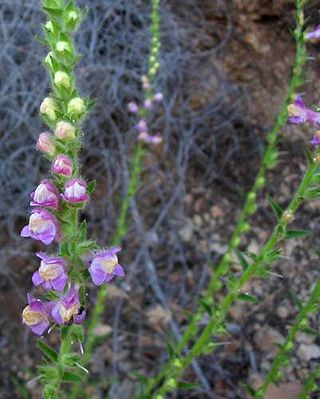
Sairocarpus multiflorus is a species of New World snapdragon known by the common name Sierra snapdragon or multi-flowered snapdragon.
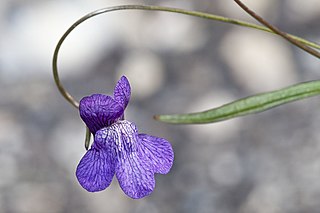
Neogaerrhinum strictum, synonyms including Antirrhinum kelloggii and Neogaerrhinum kelloggii, is a species of flowering plant in the family Plantaginaceae. It is known by the common name Kellogg's snapdragon.
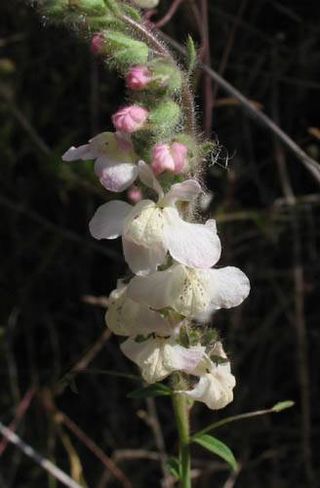
Sairocarpus coulterianus is a species of New World snapdragon known by the common name Coulter's snapdragon. Anterrhinum coulterianum is a host species for the Edith's checkerspot butterfly.

Sairocarpus cornutus, synonym Antirrhinum cornutum, is an uncommon species of New World flowering plant in the family Plantaginaceae, known by the common name spurred snapdragon.

Neogaerrhinum filipes, synonym Antirrhinum filipes, is an annual species of North American flowering plant in the family Plantaginaceae. It is known by the common name yellow twining snapdragon. This herbaceous plant is native to deserts of the southwestern United States and northern Mexico, where it is common.
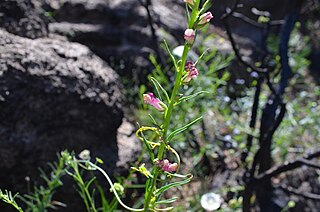
Sairocarpus virga is a species of New World snapdragon known by the common name tall snapdragon.

Trifolium cyathiferum is a species of clover known by the common names cup clover and bowl clover.

Stenoptilodes antirrhina, the snapdragon plume moth, is a moth of the family Pterophoridae. It is known from California in the United States, but also from greenhouses in the south-eastern U.S. that have received cuttings of snapdragon from California.

The Antirrhineae are one of the 12 tribes of the family Plantaginaceae. It contains the toadflax relatives, such as snapdragons.

Sairocarpus is a genus of the family Plantaginaceae, and is one of a group of plants commonly known as 'snapdragons'. It has ten accepted species and is being considered to include many species formerly considered as New World species of Antirrhinum.

Neogaerrhinum is a genus of the family Plantaginaceae, and is one of a group of plants commonly known as 'snapdragons'. It has two accepted species and includes species formerly considered as New World members of Antirrhinum.
















